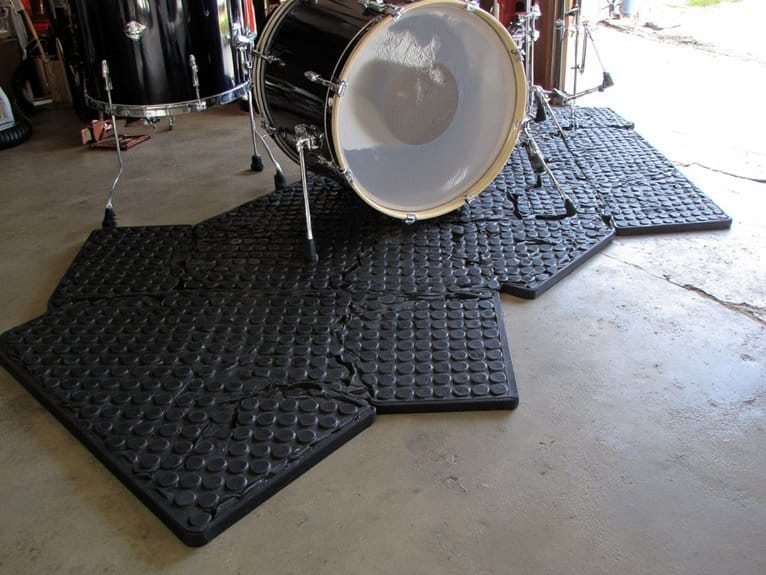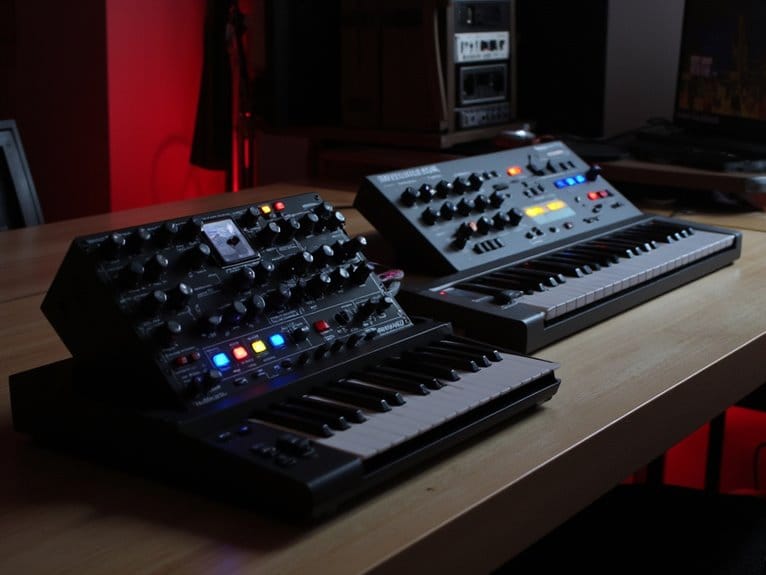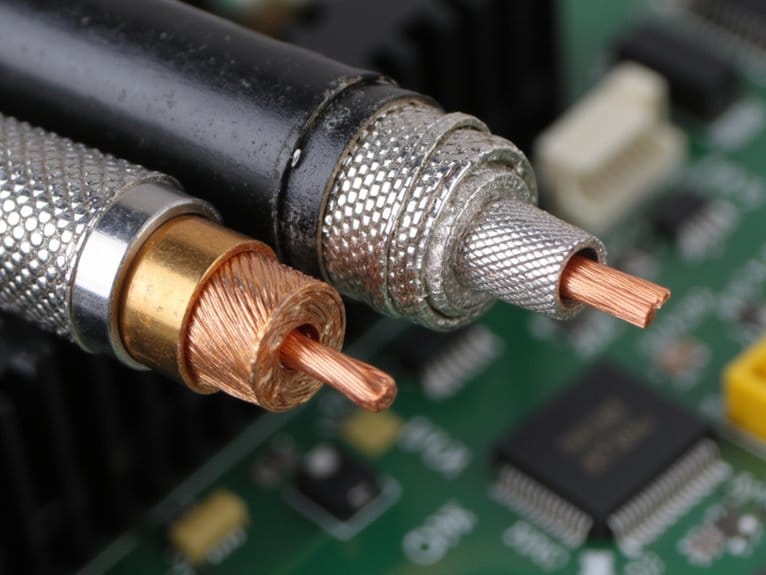Floor Protection and Drum Mat Essentials
You’ll need a quality drum mat with non-slip backing to prevent your kit from creeping during intense sessions while protecting floors from scratches, dents, and moisture damage. Look for 6.5mm thick polyester filament construction with waterproof surfaces, reinforced edges, and vibration-absorbing properties that reduce noise transmission by 15-20 STC points. Dense rubber compounds resist tearing under heavy hardware placement, while military-grade backing materials maintain stability without curling, and understanding these specifications helps you make informed decisions about ideal configurations.
We are supported by our audience. When you purchase through links on our site, we may earn an affiliate commission, at no extra cost for you. Learn more.
Notable Insights
- Drum mats prevent floor scratches, dents, and indentations caused by heavy hardware components and concentrated pressure points during playing.
- Non-slip backing technology using PVC compounds and urethane resin layers keeps drum kits stable and prevents equipment movement.
- High-quality rubber construction with reinforced edges provides durability against repeated hardware placement and aggressive playing sessions.
- Vibration absorption reduces noise transmission by 15-20 STC points while protecting floors from moisture damage and warping.
- Waterproof surfaces enable easy cleanup while portable designs allow compact folding for transport between gigs and practice sessions.
Understanding Drum Mat Functions and Core Benefits
Behind every great drum performance lies an often-overlooked foundation that I’ve learned makes all the difference in both sound quality and equipment preservation.
Drum mats serve multiple critical functions that transform your playing experience, starting with drum stability that prevents the frustrating “creep” phenomenon where your kit gradually shifts during intense sessions. The non-slip surface counters natural movement from aggressive playing, while rubber undersides and bass drum stoppers enhance grip on smooth surfaces.
Beyond equipment control, these mats prioritize floor safety by creating a protective barrier against scratches, dents, and costly indentations from hardware spikes. The durable materials distribute weight evenly from stands and pedals, preventing concentrated pressure points that could damage your flooring.
They also absorb vibrations that would otherwise transmit through floors, reducing noise complaints while improving your overall sound clarity and recording quality. Professional drummers understand that proper floor isolation creates optimal conditions for precise audio monitoring during practice and performance sessions. When selecting a mat, room size considerations ensure your drum rug provides adequate coverage for both your kit dimensions and performance space requirements.
Essential Features That Define Quality Drum Mats
When you’re shopping for a drum mat, I’ve learned that three fundamental features separate the mediocre options from the ones that’ll actually protect your floors and keep your kit stable during those intense practice sessions.
The material construction, which typically involves heavy-duty polyester filament around 6.5mm thick, directly impacts how well your mat withstands repeated hardware placement, foot pedal abuse, and the general wear that comes with regular drumming.
You’ll also want to pay close attention to the non-slip backing technology, usually 2.5mm rubber or PVC gel, and the overall size standards, since these elements work together to determine whether your investment actually prevents hardware creep or just looks good sitting under your kit. Professional mats feature waterproof surfaces that allow for quick cleanup with soap and water after messy gigs or practice sessions.
Material and Construction Quality
The foundation of any reliable drum mat lies in its material composition, where manufacturers typically blend high-quality rubber or synthetic compounds with industrial-grade carpet fibers to create a surface that’s both durable and functional.
You’ll find that dense rubber construction resists tearing and deformation under heavy pedal impacts, while reinforced edges prevent the curling and fraying that plague cheaper alternatives.
Multi-layer construction combines rubber bases with specialized foam layers, delivering enhanced shock absorption that translates to genuine performance enhancement during intense playing sessions.
Modern mats increasingly incorporate material sustainability through eco-friendly compounds that don’t compromise durability, and premium options maintain their shape and grip over extended use, ensuring your investment withstands the rigors of regular practice and performance.
Just as drummers consider material and construction quality when selecting drumheads for optimal sound and durability, the same attention to material specifications ensures your drum mat provides the stability and protection needed for consistent performance.
Non-Slip Backing Technology
Nothing matters more for drum mat performance than what’s happening underneath, where sophisticated non-slip backing technology determines whether your kit stays put or slides around like it’s auditioning for a comedy sketch.
The non slip advantages of modern backing materials range from polyester filament surfaces that grip carpets and hardwood floors, to military-grade nylon with Velcro systems that anchor pedals mechanically. PVC-based compounds resist curling while maintaining consistent floor contact, though lighter acoustic kits sometimes lack sufficient downward force to engage friction fully.
Urethane resin layers provide dual functionality, absorbing vibrations while enhancing grip across concrete, tile, and wood surfaces. These patented undersides guarantee your hardware stays precisely where you place it, performance after performance.
Size and Thickness Standards
Five fundamental dimensions separate amateur-grade mats from professional drum rug solutions, and I’ve learned through countless studio sessions that getting these measurements wrong can transform your carefully tuned kit into a sliding, unstable mess that’ll have you chasing cymbals across the room.
Understanding size variations starts with your kit’s actual footprint, where common dimensions range from 4′ x 6′ for compact setups to 6.5′ x 5.33′ for full-sized configurations. However, thickness considerations prove equally critical, as I’ve discovered that 3mm options work for light practice while 8mm models handle aggressive playing styles.
| Size Category | Dimensions | Thickness Range |
|---|---|---|
| Compact | 5′ x 2.5′ | 3-5mm |
| Standard | 4′ x 6′ | 5-6mm |
| Professional | 59″ x 47″ | 6-8mm |
| Large Kit | 78″ x 63″ | 8mm+ |
| Custom | Variable | 3-9.5mm |
Protecting Your Floors From Drum Equipment Damage
Your drum kit poses three primary threats to your flooring that can turn an expensive investment into a costly repair bill.
Hardware components like spurs, legs, and pedals create concentrated pressure points that dent soft surfaces, while the constant movement during play generates scratches and abrasion marks across wood, vinyl, and laminate floors.
Moisture from sweat, humidity changes, and damp equipment cases adds another layer of potential damage, causing wood warping, finish deterioration, and creating conditions for mold growth beneath your kit. Heavy drum components, with some snare drums weighing 11 pounds or more, can create permanent indentations in carpet and soft flooring materials over time.
Professional drummers often invest in weatherproof materials and protective solutions to safeguard both their equipment and performance surfaces from these environmental threats. Quality drum rugs with rubber backing provide essential protection by distributing weight evenly and preventing hardware from making direct contact with your floors.
Preventing Scratches and Dents
Every drummer I’ve worked with has learned this lesson the hard way: drum equipment can absolutely destroy your floors if you don’t take proper precautions. The secret to effective scratch prevention lies in understanding how drum mats distribute weight evenly, eliminating those devastating pressure points from hardware legs that create permanent dents in hardwood and tile surfaces.
For serious dent mitigation, you’ll want mats with plush or velvet surfaces that cushion your hardware while providing rock-solid stability. I’ve seen too many beautiful floors ruined by bass drum pedals and hi-hat stands that shift during intense playing sessions, dragging across surfaces and leaving irreversible scratches.
The non-slip backing on quality mats prevents this movement entirely, absorbing vibrations that cause micro-damage over time.
Moisture Barrier Protection
While scratches and dents grab most drummers’ attention, I’ve discovered that moisture damage often poses the far more expensive threat to your floors over time. Moisture detection becomes critical when you’re dealing with heavy drum equipment that can trap humidity beneath mats, creating perfect conditions for warping, buckling, and mold growth in hardwood or laminate flooring.
| Barrier Type | Barrier Lifespan | Best Application |
|---|---|---|
| Polyethylene | 10-15 years | General concrete subfloors |
| Foam underlayment | 5-10 years | Easy DIY installation |
| Bituminous membrane | 20+ years | Commercial drum studios |
| Cementitious liquid | 15-20 years | High-moisture basements |
| Lithium silicate | Permanent | Professional installations |
I’ve learned that investing in proper moisture barriers saves thousands in flooring replacement costs.
Reducing Hardware Impact
When I first started drumming seriously, I learned the hard way that drum hardware creates two distinct types of floor damage: sliding scratches from equipment that shifts during play, and pressure dents from concentrated weight points like kick pedal assemblies and throne legs.
Impact cushioning becomes vital when you’re dealing with heavy hardware that concentrates force into small contact points, creating permanent indentations on hardwood and tile surfaces.
I’ve found that thick, durable mats with dense backing provide the best protection, distributing weight more evenly across floor surfaces. Just like drummers consider weight considerations important for transport flexibility when selecting cymbals, the same principle applies to choosing floor protection that balances portability with effective coverage.
Stabilizing solutions like non-slip materials under hardware prevent the sliding damage, while targeted padding beneath pedal assemblies offers essential shock absorption that protects against those concentrated pressure points.
Features like anti-slip feet on modern hardware stands help prevent movement during performances, but additional floor protection remains essential for complete damage prevention.
Noise Control and Vibration Management Solutions
As someone who’s spent countless hours trying to convince neighbors that my drumming isn’t actually an act of war, I’ve learned that effective noise control requires a multi-layered approach that addresses both airborne sound and structural vibrations.
Your best defense against drum noise starts with proper vibration isolation using rubber floor underlayment, which can improve your floor’s STC rating by 15-20 points. Dense impact barriers made from recycled tire rubber absorb both impact and airborne noise traveling through floors, while rubber mats placed directly under your kit prevent vibration transfer to subfloors.
Adding heavy carpeting over underlayment further enhances sound absorption, creating an all-encompassing system that reduces noise transmission to spaces below your drum room.
Choosing the Right Size and Configuration for Your Setup
Once you’ve addressed the noise traveling through your floors, you’ll need to focus on selecting a drum mat that properly fits your specific kit configuration, because even the most sophisticated vibration isolation won’t help if your hardware’s sliding across unprotected flooring during an intense fill.
I’ve found that mat size depends heavily on your setup variations, with standard options ranging from 5.5′ x 4.5′ compact rugs to larger 6.5′ x 5.33′ models that accommodate full acoustic kits.
Your pedals, snare, and floor toms should rest completely on the mat’s surface, while weighted corners prevent curling during play. Compact electronic setups work fine with smaller mats, but multiple floor toms demand extra coverage for stability and thorough floor protection.
For practice sessions where noise reduction is critical, incorporating practice pads can help maintain your technique while minimizing volume levels that might disturb neighbors or household members.
Practical Considerations for Transport and Durability
While selecting the perfect mat size matters tremendously, I’ve learned through countless load-ins and teardowns that your drum mat’s portability and long-term durability will ultimately determine whether it becomes an essential part of your setup or an expensive garage sale item.
Smart transport logistics start with choosing mats that fold compactly, resist tears from sharp drum edges, and maintain their non-slip properties after repeated use. I’ve watched too many drummers invest in premium mats only to abandon them because they’re impossible to carry or fall apart after a few gigs.
Effective durability strategies include selecting puncture-resistant materials, proper thickness for load distribution, and surfaces that won’t degrade from constant equipment contact, moisture exposure, or temperature fluctuations during storage.
On a final note
You’ve got all the information you need to make a smart drum mat decision, and honestly, it’s not rocket science once you understand the basics. Whether you’re protecting hardwood floors, controlling vibrations that drive your neighbors crazy, or hauling gear to weekend gigs, the right mat makes everything easier. Don’t overthink it-focus on size, material quality, and your specific needs, then you’ll be set.







